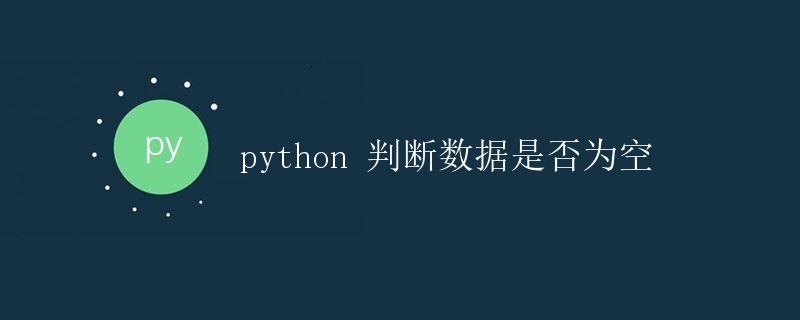Python 判断数据是否为空

数据判断是编程过程中常常遇到的问题之一。在 Python 中,我们可以使用多种方法来判断数据是否为空。本文将详细介绍这些方法,并给出相应的示例代码。
1. 判断字符串是否为空
字符串是一种常见的数据类型,在判断字符串是否为空时,我们可以使用以下方法:
1.1 使用 if 语句判断字符串是否为空
def is_empty_string(s):
if s:
print("字符串不为空")
else:
print("字符串为空")
is_empty_string("") # 输出:字符串为空
is_empty_string("Hello") # 输出:字符串不为空
1.2 使用 len() 函数判断字符串是否为空
def is_empty_string(s):
if len(s) == 0:
print("字符串为空")
else:
print("字符串不为空")
is_empty_string("") # 输出:字符串为空
is_empty_string("Hello") # 输出:字符串不为空
1.3 使用 strip() 方法判断字符串是否为空
def is_empty_string(s):
if s.strip(): # 去除字符串两端的空格后再判断是否为空
print("字符串不为空")
else:
print("字符串为空")
is_empty_string("") # 输出:字符串为空
is_empty_string(" ") # 输出:字符串为空
is_empty_string("Hello") # 输出:字符串不为空
2. 判断列表是否为空
列表是一种常用的数据结构,在判断列表是否为空时,我们可以使用以下方法:
2.1 使用 if 语句判断列表是否为空
def is_empty_list(lst):
if lst:
print("列表不为空")
else:
print("列表为空")
is_empty_list([]) # 输出:列表为空
is_empty_list([1, 2, 3]) # 输出:列表不为空
2.2 使用 len() 函数判断列表是否为空
def is_empty_list(lst):
if len(lst) == 0:
print("列表为空")
else:
print("列表不为空")
is_empty_list([]) # 输出:列表为空
is_empty_list([1, 2, 3]) # 输出:列表不为空
3. 判断字典是否为空
字典是 Python 中重要的数据结构之一,在判断字典是否为空时,我们可以使用以下方法:
3.1 使用 if 语句判断字典是否为空
def is_empty_dict(dct):
if dct:
print("字典不为空")
else:
print("字典为空")
is_empty_dict({}) # 输出:字典为空
is_empty_dict({"name": "Alice", "age": 20}) # 输出:字典不为空
3.2 使用 len() 函数判断字典是否为空
def is_empty_dict(dct):
if len(dct) == 0:
print("字典为空")
else:
print("字典不为空")
is_empty_dict({}) # 输出:字典为空
is_empty_dict({"name": "Alice", "age": 20}) # 输出:字典不为空
3.3 使用 bool() 函数判断字典是否为空
def is_empty_dict(dct):
if bool(dct):
print("字典不为空")
else:
print("字典为空")
is_empty_dict({}) # 输出:字典为空
is_empty_dict({"name": "Alice", "age": 20}) # 输出:字典不为空
4. 判断集合是否为空
集合是 Python 中用于存储非重复元素的数据结构,在判断集合是否为空时,我们可以使用以下方法:
4.1 使用 if 语句判断集合是否为空
def is_empty_set(s):
if s:
print("集合不为空")
else:
print("集合为空")
is_empty_set(set()) # 输出:集合为空
is_empty_set({1, 2, 3}) # 输出:集合不为空
4.2 使用 len() 函数判断集合是否为空
def is_empty_set(s):
if len(s) == 0:
print("集合为空")
else:
print("集合不为空")
is_empty_set(set()) # 输出:集合为空
is_empty_set({1, 2, 3}) # 输出:集合不为空
5. 判断其他数据类型是否为空
对于其他数据类型,我们可以使用以下方法来判断是否为空:
5.1 使用 if 语句判断数据类型是否为空
def is_empty(data):
if data:
print("数据不为空")
else:
print("数据为空")
is_empty(None) # 输出:数据为空
is_empty(0) # 输出:数据为空
is_empty(False) # 输出:数据为空
is_empty([]) # 输出:数据为空
is_empty({}) # 输出:数据为空
is_empty(set()) # 输出:数据为空
5.2 使用 bool() 函数判断数据类型是否为空
def is_empty(data):
if bool(data):
print("数据不为空")
else:
print("数据为空")
is_empty(None) # 输出:数据为空
is_empty(0) # 输出:数据为空
is_empty(False) # 输出:数据为空
is_empty([]) # 输出:数据为空
is_empty({}) # 输出:数据为空
is_empty(set()) # 输出:数据为空
总结
本文详细介绍了在 Python 中判断不同数据类型是否为空的方法。对于字符串、列表、字典和集合等常见的数据类型,我们可以使用 if 语句、len() 函数和 strip() 方法来进行判断。对于其他数据类型,我们可以直接使用 if 语句或者 bool() 函数来判断是否为空。
判断数据是否为空在编程中非常实用,可以帮助我们避免处理空数据时出现的错误。根据实际需求,选择合适的方法来判断数据是否为空非常重要。
 极客教程
极客教程